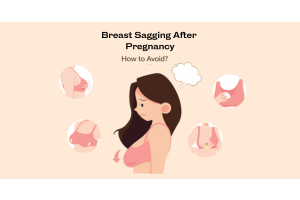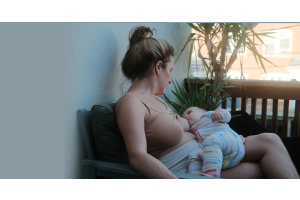Pregnancy marks occur due to hormonal changes during pregnancy and the growing belly, resulting in the appearance of lines on the stomach. Do you know if it’s possible to prevent pregnancy marks? Here are 5 major methods to combat pregnancy marks so that even mothers who have already developed them don’t need to be afraid. There are ways to eliminate pregnancy marks!
Table of Contents
What are the pregnancy marks?
Stretch marks, also known as striae, include pregnancy marks, growth marks, and obesity marks. The difference lies in the changes related to pregnancy in pregnancy marks. As long as it is a stretch mark, in the initial stage of injury to the dermis, many symmetrical, reddish, or purplish, irregular band-like patterns will first appear. They are usually raised and can be felt. This stage is called the initial response of pregnancy marks, also known as “red marks” or striae rubrae, due to their color. After a period of time, the scars will gradually shrink, blood vessels will fade, and they will become silver-white marks, known as “white marks” or striae albae.


Stretch marks became noticeable during pregnancy
Under the influence of hormones, the production of estrogen increases, resulting in a decrease in the skin’s ability to repair itself. The secretion of cortisol by the adrenal glands also increases threefold, inhibiting the growth of elastic fibers in the dermis of the skin. This leads to the breakdown of elastic fibers and damage to collagen fibers, causing a decrease in skin elasticity.
During pregnancy, the skin on the abdomen stretches and becomes thin, leading to itching and even some pain. Scratching during this time can cause varying degrees of damage or breakage to the fibers, resulting in the appearance of pink or purple wave-like patterns of different widths and lengths, commonly known as stretch marks.
-
The skin becomes dry and loses elasticity.
-
The damaged skin feels painful.
-
The skin becomes dehydrated and itchy.


Various colours of stretch marks
-
Pink: Early pregnancy or a small pregnant belly, a warning sign of early appearance of stretch marks.
-
Red: The initial formation of stretch marks with the rupture of elastic fibers in the skin, commonly seen during the second trimester.
-
Purple-red: Rupture of the skin’s fibrous layer and a lack of collagen, often seen during the third trimester. Recommended to use a maternity belt to relieve pressure on the abdominal skin and reduce skin stretching.
-
Reddish-brown: Rupture of the skin’s elastic fibers, forming prominent scars, commonly seen during the third trimester.
-
White: Marks left behind when the connective tissue completely ruptures and fails to fade in a timely manner after childbirth.
-
Silver-white: Gradually fades and shrinks, difficult to repair.


The most common location of stretch marks during pregnancy
Most mommies usually experience this during the period of pregnancy, around seven to eight months, commonly in the abdomen, some may occur in the hip, arms, thighs, buttocks or breasts, and so on.
High-risk group for stretch marks
- Excessive or rapid weight gain during pregnancy can cause the condition of pregnancy-induced obesity to be more evident.
- It is recommended to focus on daily care before pregnancy if your mother has had stretch marks during pregnancy, as the probability of developing stretch marks for the mother will be higher.
- Lack of exercise and inadequate skin massage can also cause the skin to lack elasticity.
- Younger individuals (especially those under 20), overweight individuals (BMI > 26), those who gain excessive weight during pregnancy, experience significant changes in waist and hip measurements, have low levels of vitamin C in the blood, consume less water, have low levels of relaxin in the blood, and have insufficient extensibility of collagen and elastin proteins are at higher risk of developing stretch marks. Individuals over 35 years of age have poor self-metabolism, loss of skin elasticity and collagen, and decreased body repair mechanisms, making them more prone to developing stretch marks.
- The risk of developing stretch marks is higher in cases of large fetuses or multiple pregnancies, such as twins, as the uterus is stretched to a larger extent.


Stages of developing stretch marks easily
- Early pregnancy without diligent care
During the early stages of pregnancy, many expectant mothers experience morning sickness and a decrease in appetite, which may even cause them to lose weight compared to before pregnancy. Although the probability of developing stretch marks is lower, it is recommended that mothers start taking care of areas such as the abdomen, hips, and chest from the early stages, as these are more prone to stretch mark formation.
- The fetus grows rapidly in the late stage of pregnancy
At 24 weeks pregnant, there will be an increase in amniotic fluid, thickening of the uterine lining, and rapid growth of the fetus. The growth of the fetus gradually stabilizes, and the baby bump expands quickly. If mothers do not take care properly in the earlier stages, it is easier to develop stretch marks. When the skin is stretched thinner and thinner, it may also be accompanied by itching and discomfort. Stop scratching to prevent further damage to the dermis and the formation of stretch marks.
Tips to prevent stretch marks
- Control body weight: Weight gain is one of the most important factors in the development of stretch marks. During pregnancy, weight should be gradually increased instead of rapid weight gain.
- Supplement water and nutrients: Have a balanced and moderate diet, especially in the later stages of pregnancy. Follow the principle of “quality over quantity” and control the intake of fats and carbohydrates. Additionally, consume more water, protein, fiber, vitamins, etc.
- Supplement collagen: Foods rich in collagen help increase skin elasticity. It is recommended for pregnant mothers to first adjust their own digestive capacity. Only with good digestive absorption, the food consumed will be effective. Foods containing collagen should also be consumed in moderation, preferably from plant-based sources such as black fungus, white fungus, okra, etc., to avoid excessive calorie intake leading to weight gain, which may have the opposite effect. In addition, pregnant mothers should eat more fruits containing vitamin C to promote collagen production.
- Regular exercise: Regular and appropriate exercise can promote metabolism and prevent excessive weight gain. Furthermore, exercise can stretch the skin appropriately, reducing the formation of stretch marks and preventing their occurrence. Pregnant mothers without special pregnancy issues may consider learning prenatal yoga or exercises to maintain a daily exercise routine.
- Diligently massage and care for the skin: It is recommended to choose lotions, belly oils, etc., with natural ingredients. With moderate pressure during massage, it can not only moisturize and hydrate the skin, relieve dryness and itching but also train muscle stretchability and increase skin elasticity. This can adapt to the growth of the uterus, withstand stretching, and reduce the chances of fibrous tissue rupture, thus reducing the occurrence of stretch marks.


To better prevent pregnancy marks, it is recommended to start taking care of areas such as the abdomen and chest before pregnancy, making the skin more elastic. During pregnancy, it is advised to continue massaging the skin until postnatal for better results as stretch marks do not only appear in pregnancy. Here are different methods for preventing pregnancy marks at different times.
- Pre-pregnancy
- Regular and moderate exercise
- Supplementary protein and vitamins
- Adequate hydration
- Use oily skin care products to massage the body and increase skin elasticity
- Appropriate age for childbirth, avoid early (before 20 years old) childbirth and late childbirth (after 35 years old).
2. During/ After pregnancy:
- Take supplements, collagen, and vitamins, such as beans, pork feet, and tomatoes.
- Ensure an adequate intake of water.
- Avoid taking hot showers for too long to prevent damage to the skin and excessive loss of moisture, which can lead to dryness and lack of elasticity.
- Maintain skin elasticity through regular care and massage during pregnancy to prevent the appearance of stretch marks due to stretching.
- Control weight gain and avoid excessive overeating, which can result in the accumulation of excess nutrients as fat in the body. Rapid weight gain can cause the skin to thin due to being stretched too quickly.
- Breast engorgement may lead to developing stretch marks, it is advisable to wear breastfeeding-friendly, breathable, and supportive maternity bras to avoid discomfort, itching, or the development of stretch marks from saggy breasts.
- In the later stages of pregnancy, as the fetus grows rapidly, using a support belt can help alleviate the strain on the abdomen and minimize excessive stretching of the abdominal skin.




How can I prevent and eliminate pregnancy lines using prenatal oil/skin oil?
Contains red sandalwood alcohol: Mamaway’s stretch mark oil contains red sandalwood alcohol, which has antibacterial and anti-itch effects for moms with itchy skin, preventing moms from scratching and causing stretch marks.
Moisturizing and locking water: To prevent stretch marks, it is not enough to just apply either cream or lotion, both two are essential. First, apply belly oil to the belly, allowing small moisturizing molecules to enter the skin, promoting normal arrangement of skin keratin and fiber cells, and improving skin elasticity. Then, apply moisturizing lotion to achieve the effect of oil-water balance and deep water locking.
The Mamaway stretch mark oil focuses on moisturizing the skin, relieving dryness and itching, and locking in moisture. However, what pregnant mothers are most concerned about the belly oil is stickiness, poor absorption, and oily smell. Mamaway stretch mark oil has small molecules, so it can penetrate the gaps between skin cells and be quickly absorbed without stickiness. In addition, it also contains natural plant extract essential oils, which help to alleviate the discomfort of morning sickness for mothers who are sensitive to smells during pregnancy.
It is recommended to use it 2-3 times a day, applying the oil first and then the lotion. The oil deeply moisturizes, and the lotion provides long-lasting hydration and locks in moisture. Using it twice a day helps maintain the elasticity of the skin fibers.
- Apply near the navel, draw circles clockwise, push from bottom to middle, and massage until absorbed.
- Gently apply in the middle of the chest, along the edges of the chest, and massage from bottom to top until absorbed.
- Apply on the buttocks at the base of the thighs, and massage from bottom to top along the edge of the buttocks, until absorbed.
- Apply near the thighs, and massage from bottom to top until absorbed.















Validate your login
Sign In
Create New Account